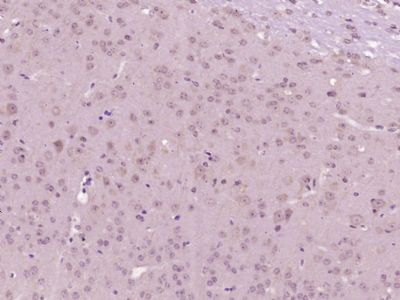产品货号 : mlR11693
英文名称 : Senataxin
中文名称 : 肌萎缩侧索硬化症相关蛋白4抗体
别 名 : SETX; ALS4; Amyotrophic lateral sclerosis 4 protein; AOA2; bA479K20.2; DKFZp781B151; FLJ12840; FLJ43459; KIAA0625; Probable helicase senataxin; SCAR1; SEN1 homolog; Setx; SETX_HUMAN.
研究领域 : 神经生物学 信号转导 表观遗传学
抗体来源 : Rabbit
克隆类型 : Polyclonal
交叉反应 : Human, Mouse, Rat, Dog, Cow, Horse, Sheep,
产品应用 : WB=1:500-2000 ELISA=1:500-1000 IHC-P=1:400-800 IHC-F=1:400-800 ICC=1:100-500 IF=1:100-500 (石蜡切片需做抗原修复)
not yet tested in other applications.
optimal dilutions/concentrations should be determined by the end user.
分 子 量 : 303kDa
细胞定位 : 细胞核 细胞浆
性 状 : Lyophilized or Liquid
浓 度 : 1mg/ml
免 疫 原 : KLH conjugated synthetic peptide derived from human Senataxin:321-398/2677
亚 型 : IgG
纯化方法 : affinity purified by Protein A
储 存 液 : 0.01M TBS(pH7.4) with 1% BSA, 0.03% Proclin300 and 50% Glycerol.
保存条件 : Store at -20 °C for one year. Avoid repeated freeze/thaw cycles. The lyophilized antibody is stable at room temperature for at least one month and for greater than a year when kept at -20°C. When reconstituted in sterile pH 7.4 0.01M PBS or diluent of antibody the antibody is stable for at least two weeks at 2-4 °C.
PubMed : PubMed
产品介绍 : SETX belongs to the DNA2/NAM7 helicase family. Localizing to the nucleolus or the nucleoplasm in a cell cycle-dependent manner and to the cytoplasm, SETX contains a C-terminal DNA/RNA helicase domain and is believed to function as a helicase involved in RNA processing and DNA repair. Mutations in the gene encoding SETX can lead to ataxia-ocular apraxia 2 (AOA2) or amyotrophic lateral sclerosis 4 (ALS4). AOA2, also known as spinocerebellar ataxia-1 (SCAR1), is an autosomal recessive disorder characterized by progressive neurodegeneration of the cerebellum associated with the loss of Purkinje cells. ALS4 is a familial childhood- or adolescent-onset neurodegenerative disorder affecting both upper and lower motor neurons that ultimately results in fatal paralysis.
Function:
Probable helicase, which may be involved in RNA maturation. Involved in DNA double-strand breaks damage response generated by oxidative stress.
Subcellular Location:
nucleolus. Cytoplasm. May be detected in the nucleolus only in cycling cells (By similarity). Most abundant in the nucleus. Detected in granules. Colocalized in cycling cells with FBL in the nucleolus.
Tissue Specificity:
Highly expressed in skeletal muscle. Expressed in heart, fibroblast, placenta and liver. Weakly expressed in brain and lung. Expressed in the cortex of the kidney (highly expressed in tubular epithelial cells but low expression in the glomerulus).
DISEASE:
Defects in SETX are the cause of spinocerebellar ataxia autosomal recessive type 1 (SCAR1) [MIM:606002]; also known as ataxia-ocular apraxia 2. Spinocerebellar ataxia is a clinically and genetically heterogeneous group of cerebellar disorders. Patients show progressive incoordination of gait and often poor coordination of hands, speech and eye movements, due to degeneration of the cerebellum with variable involvement of the brainstem and spinal cord. SCAR1 is an autosomal recessive form associated with peripheral neuropathy and elevated serum alpha-fetoprotein, immunoglobulins and, less commonly, creatine kinase levels. Some SCAR1 patients manifest oculomotor apraxia.
Defects in SETX are a cause of amyotrophic lateral sclerosis type 4 (ALS4) [MIM:602433]. ALS4 is a familial form of amyotrophic lateral sclerosis, a neurodegenerative disorder affecting upper and lower motor neurons and resulting in fatal paralysis. Sensory abnormalities are absent. Death usually occurs within 2 to 5 years. The etiology of amyotrophic lateral sclerosis is likely to be multifactorial, involving both genetic and environmental factors. The disease is inherited in 5-10% of cases leading to familial forms. ALS4 is a childhood- or adolescent-onset form characterized by slow disease progression and the sparing of bulbar and respiratory muscles.
Similarity:
Belongs to the DNA2/NAM7 helicase family.
SWISS:
Q7Z333
Gene ID:
23064
Important Note:
This product as supplied is intended for research use only, not for use in human, therapeutic or diagnostic applications.
产品图片












